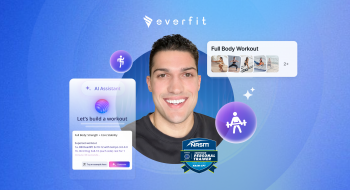Trevor Short is an exercise physiologist at the University of Hawaii, previous coach to NFL / Olympic athletes, & previous COO of a multi-million dollar training studios. Now he’s teaching you the essential concepts of designing a fitness program. You’ll learn how to perform a needs analysis & a comprehensive assessment, the foundational principle of designing a fitness program, and ancillary topics in exercise prescription. Learn the essentials of programming to the next level with these key considerations.
Transcript
All right, let’s get into the primary content. So the first thing we’re going to talk about is a comprehensive assessment. Okay, so in most settings, it’s really, really critical to have an entire comprehensive assessment with an individual before you create a program. And you can do this multiple ways. If you work online, you can do this through Google forums and videos, if you work in person, and so on. But having a comprehensive assessment, creating a big picture and generalized looking view of an individual is a critical first step in creating a really sound program. So first step, informed consent exercise, pre participation, health screening, this is more for a clinical setting. This also includes a liability waiver. But make sure you’re coming correct with the paperwork, make sure that you’re covering yourself. Second thing is pre exercise evaluation, and this is someone’s goals, objectives, etc. This really is where the soft skills come in. So how is your ability to interact with their clients, how’s your ability to get them to express their goals, get them to express the objectives, and really talk them into creating a SMART goal, right, finding a goal that’s actually Specific, Measurable has an action item, it’s truly attainable.
It’s realistic and timely. So creating a proper SMART goal will be huge in this first first stage, getting some resting measurements. Again, this could be clinical, if needed. But this can be resting heart rate, resting blood pressure, if needed, or if your general pop or sport performance setting, this might not be as important, but I still do like to get resting heart rate measures with anybody that I work with. Because heart rate variability definitely has a sway and tells you a lot about the training, stress and stimulants that somebody might be on.
And then getting into the specifics. These are the ones that are critical and absolutely should be always included in a comprehensive initial assessment, either circumference or body composition analysis, ideally, both but getting someone circumferences analyzing their body fat percentage, and lean muscle mass or lean mass percentage is going to be critical, especially to be able to show them pre post changes. Measuring cardiorespiratory fitness. So this could be a 1.5 mile run test, this could be if you have access to via to max test, this could be a critical power test, there’s a lot of ways to define and measure cardiorespiratory fitness. But this should also be one primary component of a comprehensive assessment, measuring muscular fitness or muscular fitness . Iincluded in that term is both muscular endurance as well as muscular strength. So getting a percent or getting a 1RM value from repetition, maximum testing, as well as measuring their muscular endurance and measuring flexibility/mobility will be critical as well. This doesn’t all have to be done on the same day. But when you first initially get somebody as an individual, there are definite ways to create cookie cutter templates and programs for a lot of people. But if you do the Comprehensive Assessment, you can accurately prescribe correctives, accurately identify rate limiting factors, and really optimize this individual’s time with you. Because if they’re already really really strong, let’s say they’re already barbell back squatting two and a half times their body weight, but they’re really really lacking cardiorespiratory fitness. Depending on their goals. If they want to become a more healthy quote quote healthy individual, they should probably spend some time really really digging into the cardiorespiratory fitness fits. So that will change how you allocate your exercise prescription based on their strengths and weaknesses. So a comprehensive assessment is a critical first step in a solid program.
And so with that, that really kind of defines the five components of health related fitness. So in most fitness settings, individuals want one of three things. They either want to lose weight, gain muscle mass, so lose weight by decreased body fat percentage, gain muscle knots, or improve performance in some type of sport, activity and so on. And that’s a generalization but most people are going to want to do that. And so within that if you consider the five components of health related fitness if an individual wants to become more healthier, whatever that might be, these five components are probably the most important from a health standpoint to measure so cardiovascular endurance, muscular strength, muscle endurance, flexibility, and body composition. In other words, what these five variables really mean is that if you’re improving one of these five things, you’re improving this individual’s health. And that’s really, really important not only to understand, but also to relay to your clients that hey, okay, you want to become a more healthy individual. These five components really define health related fitness. Okay, here’s what your strong and here’s what your weak and you can show pre post adaptations that are four weeks, eight weeks, 12 weeks of training, and so on. But these five components are really going to be kind of the basic foundational principles and variables to focus on when considering health related fitness and the essential oils within health.
Alright, so once you’ve done the comprehensive analysis, let’s say you have a lot of information on each individual and their mobility, their strengths, their weaknesses, their fitness level, their mental status profile, the next step is developing a needs analysis. And I think the needs analysis, to be honest, is the most important and critical part of a trainer practitioner’s role in creating a proper needs analysis. I think the details within the needs analysis, separate good trainers from Elite trainers. And what it needs analysis says is basically an in depth analysis of the physical demands of this individual’s life, their sport and physical demands and their mental profile. Right. So what a needs analysis entails. And we’ll talk about some of the specifics are getting a little bit deeper here, but what is the needs or the demands that are placed on this individual in their life, in their sport, in their physical mental world and realm? Right? And is there? What’s their rate limiting factor? Okay, so out of after, like the assessment, and you have the information, which of these variables is limited, which can help improve their capacity, their functional capacity to do that thing. So you do have some common primary objectives within this, decrease your risk of injury, enhance performance, reach desired goal, or enhance your quality of life? Again, these are just common generalizations. But let’s take an example of a collegiate athlete, for example, a soccer player, the depth that you can go in the needs analysis really, really will separate how solid your program is. So you can think about bioenergetic specificity. What energy system are they predominantly using in their sport? Or did they need to perform in their sport? Where are they strong? And where are they weak? Therefore, where should you allocate a big chunk and percentage of their training? Right? Within that you have the biomechanical specifics of this collegiate athlete, let’s say they’re a soccer player. In soccer, the gate looks slightly different than it might look in long distance running, specifically, because there’s a ball involved. So a lot of times you’re looking at the ground, there’s more forward lean, there’s a lot more acceleration involved. So are you going to spend a lot more time working on top speed with the soccer player? Are you going to work more on footwork, mechanics and acceleration profile within the soccer player as well, right.
Other things that will come up in the needs analysis is individuals’ injury history, right, their risk of injury, common injuries that happen in the sport, and so on. So you can go really, really deep, and take a deep dive in the needs analysis for each individual. But if you create a solid foundation of the needs analysis, what you’ll realize is that it’s all about the details. So a really, really great needs analysis will one identify the needs and demands of the individual in their life, to identify the stresses and stimulus that are already present in that person’s life, aka, if they’re a basketball player, and they’re playing five or six times a week for a couple hours, you might not necessarily need to train them for those basketball specific movements, because they’re already doing it so much, that maybe you need to work on those other things that they’re not getting right and work around those other baseline principles to improve their capacity, their functional capacity to play. Let’s say they’re a tech worker that works in the Bay Area, they’re spending a lot of time sitting, right? So has the trunk is flexed forward as a hit might lock up and they might decrease their ability to access the glue that will also really impact the organization of your training, which exercise come first and also the allocation of time towards specific details, corrective strength training, and so on, compared to if this individual is walking quite a bit throughout the day, and so on. So how deep that you take your needs analysis will directly relay into how well you can improve this person’s capacity by creating a really solid program right. Now if the individual doesn’t stick with the program and adherence and other things other topics and concepts, but at the basis of creating a solid program lies the needs analysis.















